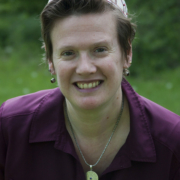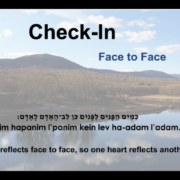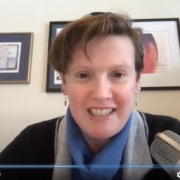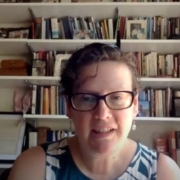This year, the b-mitzvah students and I are studying Jewish values. At the start of the school year we focused on teshuvah, repentance or return — the value at the heart of the Days of Awe. After that, we began a unit on b’tzelem Elohim: the idea that we are all made in the image of God.
If you can’t see the embedded video, above, it’s here on YouTube. You can also read the text of the video below.
Dear CBI Community,
As we look toward hopefully offering hybrid services this summer, I’m here to share some of the challenges and opportunities involved in shifting from all-digital offerings to hybrid ones. Of course there’s the challenge of staying on top of changing CDC guidance! But aside from the medical, there are also practical, spiritual, and communal impacts to how we make that shift.
I’m part of two clergy groups that arose at the start of the pandemic. One consists of about 3000 Jewish clergy from across the denominations. The other is for clergy of all faith traditions, and has 7500 members. In both of these groups, we share questions, resources, and emerging best practices. What we’ve been doing at CBI draws on the cumulative wisdom of all of these folks.
When I lead prayer over Zoom, I screenshare slides that feature images and artwork and sometimes even video clips alongside the words of our prayers… and at strategic moments in the service, there’s a slide that reminds me to stop the screenshare so that we can all see each other’s faces, wave to each other, and remember that we’re connected in community together.

Some of us use the chat function in Zoom to connect with each other during services, chatting with each other via text, or sending a chat message to the whole room (for instance, if I ask people to share a blessing that they’re thankful for this week, or when I ask for names for healing.) Sometimes I call on people to lead a prayer from the place where they are.
One of the ways we’ve sought to sustain our community during the pandemic is through making our Zoom offerings as interactive as possible. Because of that interactivity, members and friends of CBI who live elsewhere or have moved away can join us not only in prayer but in seeing each others’ faces, texting each other messages, and being connected across distance.
As we approach the next phase of the pandemic and the return to some in-person prayer, one of the biggest questions is: how can we make services most meaningful and participatory both for the “Roomies” (physically present) and the “Zoomies” (participating remotely)? Is there a way to do so that truly serves both of these constituencies, and that “works” for both groups at once?
Once we’re back at the shul, it’s easy to share a service via Zoom / Facebook Live — but that’s a broadcast paradigm, not an interactive one. Those who are remote can’t participate as fully, and can’t share their faces or voices with each other or with those in the room. That’s how we used to stream high holidays. But it’s not interactive, unlike what we’ve done over this pandemic year.
Across the denominations, we’re all grappling with how the pandemic has changed how we do Jewish and how we constitute community. We’ve spent more than a year “making a minyan” from afar, spanning from North Adams to Florida to California. The tenth member of our minyan might be in another time zone! That changes our felt sense of what it means to be together.
It’s a paradigm shift for Jewish life everywhere. And we may not wholly understand its impacts until we can look back on this moment, five or ten or fifteen years from now. One thing that is clear is that this new way of constituting and connecting community opens doors for those who are disabled or homebound, and we need to figure out how to keep those doors open.
Some communities are now installing large screens in their sanctuaries, one to show the digital prayer materials (also shared over Zoom) and another to show the grid of all the faces participating on Zoom, so that those on Zoom can see who’s in the sanctuary and vice versa. Some schools operate that way now, and businesses too. Of course, that’s a major investment.
We don’t yet have answers on how best to do this. (As a recent essay from the Union for Reform Judaism points out, no one does — and they have wise thoughts on why we should be thinking in terms of “multi-access” offerings, not just “hybrid” ones.) But these are some of the questions that clergy across the denominations and across faith traditions are grappling with.
I know you’re probably eager to know what we’re going to do for the Days of Awe. I am too! The Board is exploring everything from tent rental, to screen(s) in the sanctuary, to whether it’s safe for people who are vaccinated and masked to sing together, to what’s best for our unvaccinated children and their families. Thanks to all who filled out our survey: your answers help us plan.
If you have thoughts about going forward, I welcome them. Please know that I always want to hear from you about what you want and need, or about whatever’s on your mind and heart.
For now, I wish you every blessing during this final week of the Omer, and I hope to see you at Shabbat services (at 10:30 ET this week!) and at Shavuot, starting 7:30pm on Sunday May 16.
Tradition says that the soul of every Jew who ever was and ever will be were all mystically together at Sinai to receive Torah. That’s what we’ll celebrate on Sunday night: the continuing revelation of Torah, and our togetherness across time and space. We’ll begin with evening services and Yizkor, and then enjoy diverse learning offerings until midnight.
See you at Sinai… and on Zoom at CBI!

Hello all! Here’s a short video message from Rabbi Rachel – a story from Talmud, a reflection on where we are in the solar year, and a blessing for hope and comfort and light in the darkness.
If you can’t see the embedded video, you can go directly to it here on YouTube.
Here’s a short video message from Rabbi Rachel. You can watch it / listen to it here, or, if you prefer, you can read the text below.
Hello friends.
I’m here because I wanted to say hi and that I’m thinking of you.
It was a joy to be with many of you during the Days of Awe in various ways — on Zoom, and via Facebook live, and for our socially distant and masked Tashlich service on the suspension bridge. It was a joy to sing with you and pray with you and mark that holy season with you. And it was a joy to be with you on Zoom during Sukkot! And now we’re in the quiet season, the open space after all of the fall holidays, like the silence that falls after a song.
I continue to hold every one of you in my prayers and in my heart.
I know that many of us are feeling increased anxiety these days.
Sometimes we can look at our anxiety and think: okay, that’s just my brain, doing what brains do. And sometimes we look at the world around us, and anxiety feels like a reasonable response!
I read in the Washington Post recently that while every presidential election feels important, this one may feel uniquely so — and a lot of people, on both sides, fear that America’s future is dark if the other side wins. That’s a difficult and scary place to be.
Meanwhile, around the nation the pandemic is worsening. Record numbers of new infections have been reported in several states, and the country as a whole recently broke our record for most cases reported in a single day — not a record that anyone wanted to break.
Anxiety makes sense. And… it can also really get in the way of our ability to live.
So I wanted to share a small meditative practice
One thing that can help, when we’re in the grip of anxiety, is to notice it and name it. “Oh right: this feeling is anxiety.” Naming it distances it, a bit. It’s a feeling; it’s an experience; but it’s not ME, it’s not who I am. If it’s just a feeling, and not my essential self, then that means it comes and it goes. It isn’t forever.
Once we’ve named the feeling as anxiety, we can breathe in, and on the exhale, let breath flow out with the intention of letting go of the anxiety, too. Slow, deep breaths can help regulate the body, and because we’re integrated beings, helping the body helps the heart and mind and spirit, too. Breathing in, feeling the inhale; breathing out, letting go.
And sometimes it helps to find a physical sensation to hold on to, to shift focus away from the anxiety. Pick up a pebble or a seashell, and hold it in your hand and really feel its surface. Or touch a mint or rosemary plant and bring the scent to your face and breathe it in. (A drop of essential oil can serve that purpose too.)
I’ve been taking a lot of comfort lately in the rhythms of time that were here long before this pandemic election season, and will be here long after. Watching the trees put on their autumn show. Lighting Shabbat candles every Friday night. I hope there’s comfort for you also in the rhythms of the seasons and in the Jewish ways we mark and sanctify time.
As always, I’m here if you want to talk, and I hope to see you on Zoom soon. Thank you for being a part of CBI.
***
If the mindfulness practice here speaks to you, you might also enjoy Rabbi Jay Michaelson’s teaching Mindfulness of Cortisol.
Here’s a short video message from Rabbi Rachel, including a prayer-poem by Beth Schafer:
[youtube https://www.youtube.com/watch?v=RjrEBItVTSk]
If you can’t see the embedded video, you can go directly to it here.
Dear Congregation Beth Israel members and friends,
In the wake of our community mission to Cuba, the rabbis who took part in that trip are now offering monthly video teachings at Bayit’s Builder’s Blog for Cuban Jewish communities and interested others. January is my month to offer a teaching. Since I’m not fluent in Spanish, I wrote my teaching and recorded a five-minute video in English. Rabbi Juan Mejia translated it into Spanish, so my video has Spanish subtitles.
Although the teaching was written with Cuban Jewish communities in mind, I realized after I recorded it that it’s universal and might be of interest to y’all too, so I’m sharing it here. Here’s a five minute video teaching — or, if you prefer, you can read the text of the teaching below in English. I hope it speaks to you.
Blessings to all —
Rabbi Rachel
[vimeo 383297974 w=640 h=360]Palabras del Torá / a “vort” of Torah – R’ Rachel Barenblat from Bayit: Building Jewish on Vimeo.
Shalom chaverim y buenos dias amigos! Last month we celebrated the festival of Chanukah. Next month will bring the holiday of Tu BiShvat, known as the “new year of the trees.” But January is an in-between month. One festival is over and the next has not yet arrived.
This pause between holidays is part of spiritual life too. Spiritual life isn’t only the peak experiences when communities come together for holidays or lifecycle celebrations. Of course those are part of spiritual life! But the quiet times, the in-between times, are also spiritual life.
Jewish life — all spiritual life — has a natural ebb and flow. In Hebrew, we say ratzo v’shov. Spiritual life ebbs and flows like the tide. High tide and low tide are both part of the natural rhythm of the sea. Peak times and quiet times are both part of the natural rhythm of spiritual life.
I love our festivals and the rituals that come with them. But I also love the quiet times. They remind me that I can find holiness and sustenance in small actions that are part of my every day. These small practices are among tradition’s tools for building meaningful Jewish lives.
And I think it’s important that some of these practices don’t require us to come to a special place, to use special items, or even to speak Hebrew. We are Jewish everywhere we go, not just at synagogue. We are Jewish no matter what language we use to speak or to pray.
Here are two of my favorite daily practices. There are texts and melodies that go with them, but I think the movement of the heart is the most important thing, more important than any special words or tunes. These are two of the most essential tools in my spiritual toolbox.
The first one is thanking God when I wake up. There’s a short traditional prayer for this purpose, called Modeh Ani. You can find it in most siddurim / prayerbooks: “I am thankful before You, living and enduring God. You have restored my soul to me; great is Your faithfulness!”
I love this prayer because it reminds me that being alive is a gift. And it reminds me that even if I feel like I made mistakes yesterday, God has faith that I can be my best self today. I love the idea that just as we seek to have faith in God, we can also believe that God has faith in us.
If you don’t know the traditional words, or if they don’t speak to you, you can do this practice with the words of your own heart. When you wake up in the morning, just pause and cultivate a sense of gratitude. Once this became a habit for me, it made my mornings feel brighter.
Saying the Shema before sleep is another spiritual tool for ordinary time. First we pause before bed, and reflect on the day. We resolve to do better tomorrow, and try to let go of the day’s hurts and mistakes — both mistakes we made ourselves, and mistakes made by others.
And then we say the Shema, a reminder of the Oneness of God and a reminder that we are part of the great unity of the universe. Doing this every night is a form of daily spiritual soul-maintenance. And I think it helps me fall asleep more easily, too. My heart feels lighter.
I love how these morning and evening practices bookend my day. They help me begin and end each day with a sense of connection. And they remind me that little things can add up to more than the sum of their parts. They take only a few minutes, but their impact is deep.
Months like this one, with no big holidays, come to teach us (and then to remind us) that all of life is spiritual life. Months like this one remind us that spiritual life is made up of simple everyday actions. Everything we do is part of spiritual life… or can be, if we pay attention.
And these small daily spiritual practices are some of our Jewish tools for helping us pay attention. They help us wake up: not just from literal sleep, but from spiritual sleep. With them we can build Jewish lives that are meaningful and deep: not only at holiday times, but always.

